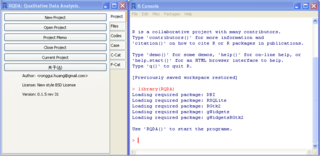Analytics is the systematic computational analysis of data or statistics. It is used for the discovery, interpretation, and communication of meaningful patterns in data. It also entails applying data patterns towards effective decision-making. It can be valuable in areas rich with recorded information; analytics relies on the simultaneous application of statistics, computer programming and operations research to quantify performance.

Grounded theory is a systematic methodology that has been largely applied to qualitative research conducted by social scientists. The methodology involves the construction of hypotheses and theories through the collecting and analysis of data. Grounded theory involves the application of inductive reasoning. The methodology contrasts with the hypothetico-deductive model used in traditional scientific research.
Digital anthropology is the anthropological study of the relationship between humans and digital-era technology. The field is new, and thus has a variety of names with a variety of emphases. These include techno-anthropology, digital ethnography, cyberanthropology, and virtual anthropology.
A video search engine is a web-based search engine which crawls the web for video content. Some video search engines parse externally hosted content while others allow content to be uploaded and hosted on their own servers. Some engines also allow users to search by video format type and by length of the clip. The video search results are usually accompanied by a thumbnail view of the video.
Online ethnography is an online research method that adapts ethnographic methods to the study of the communities and cultures created through computer-mediated social interaction. As modifications of the term ethnography, cyber-ethnography, online ethnography and virtual ethnography designate particular variations regarding the conduct of online fieldwork that adapts ethnographic methodology. There is no canonical approach to cyber-ethnography that prescribes how ethnography is adapted to the online setting. Instead individual researchers are left to specify their own adaptations. Netnography is another form of online ethnography or cyber-ethnography with more specific sets of guidelines and rules, and a common multidisciplinary base of literature and scholars. This article is not about a particular neologism, but the general application of ethnographic methods to online fieldwork as practiced by anthropologists, sociologists, and other scholars.
ATLAS.ti is a computer program used mostly, but not exclusively, in qualitative research or qualitative data analysis.
NVivo is a qualitative data analysis (QDA) computer software package produced by QSR International. NVivo helps qualitative researchers to organize, analyze and find insights in unstructured or qualitative data like interviews, open-ended survey responses, journal articles, social media and web content, where deep levels of analysis on small or large volumes of data are required.
The Forum: Qualitative Social Research is a triannual peer-reviewed online academic journal covering the theory, methodology, and application of qualitative research. The editor-in-chief has been Katja Mruck since the journal’s conception. Articles published are in English, German, or Spanish. The journal also incorporates Internet-specific forms of publication such as video and sound recordings.
Networked Insights Inc. is an analytics software company headquartered in Chicago, IL with additional offices in New York City and Madison. Founded in 2006 by entrepreneur Dan Neely, the company aims to help its customers make marketing and advertising more effective by capturing and analyzing social media conversations from blogs, internet forums, microblogs like Twitter and social networks like Facebook.

RQDA is an R package for computer assisted qualitative data analysis or CAQDAS. It is installable from, and runs within, the R statistical software, but has a separate window running a graphical user interface. RQDA's approach allows for tight integration of the constructivist approach of qualitative research with quantitative data analysis which can increase the rigor, transparency and validity of qualitative research.
Computer-assistedqualitative data analysis software (CAQDAS) offers tools that assist with qualitative research such as transcription analysis, coding and text interpretation, recursive abstraction, content analysis, discourse analysis, grounded theory methodology, etc.
Netnography, is a specific type of qualitative social media research. It adapts the methods of ethnography, is understanding social interaction in contemporary digital communications contexts. You can think of netnography as a particular set of actions for doing research within and about social media.Netnography is a specific set of research practices related to data collection, analysis, research ethics, and representation, rooted in participant observation. In netnography, a significant amount of the data originates in and manifests through the digital traces of naturally occurring public conversations recorded by contemporary communications networks. Netnography uses these conversations as data. It is an interpretive research method that adapts the traditional, in-person participant observation techniques of anthropology to the study of interactions and experiences manifesting through digital communications.
MAXQDA is a software program designed for computer-assisted qualitative and mixed methods data, text and multimedia analysis in academic, scientific, and business institutions. It is being developed and distributed by VERBI Software based in Berlin, Germany.

David Williamson Shaffer is the Vilas Distinguished Achievement Professor of Learning Science at the University of Wisconsin–Madison in the department of Educational Psychology, the Obel Foundation Professor of Learning Analytics at Aalborg University in Copenhagen, a Data Philosopher at the Wisconsin Center for Education Research, and Principal of EFGames, LLC.
QSR International is a qualitative research software developer based in Melbourne, Australia, with offices in the United Kingdom, and the United States. QSR International is the developer of qualitative data analysis (QDA) software products, NVivo, NVivo Server, Interpris and XSight. These are designed to help qualitative researchers organize and analyze non-numerical or unstructured data.
Aquad is a free computer-assisted qualitative data analysis software (CAQDAS) that supports content analysis of open data in qualitative research in psychology, education, sociology, philosophy, medicine, ethnography, politics, etc. Open data are usually collected through observation, introspection, narratives, discussion groups, interviews, etc.
QDA Miner is a mixed methods and qualitative data analysis software developed by Provalis Research. The program was designed to assist researchers in managing, coding and analyzing qualitative data.
Cassandre is a free open source software for computer assisted qualitative data analysis and interpretation in humanities and social sciences. Although it refers, like other CAQDAS-software, to Grounded Theory Method, it also allows to conduct discourse analysis or quantitative content analysis. The software is designed as a server to support collaborative work. Formerly focused on semi-automatic coding, it now provides diaries assisting qualitative analysis.

Quirkos is a CAQDAS software package for the qualitative analysis of text data, commonly used in social science. It provides a graphical interface in which the nodes or themes of analysis are represented by bubbles. It is designed primarily for new and non-academic users of qualitative data, to allow them to quickly learn the basics of qualitative data analysis. Although simpler to use, it lacks some of the features present in other commercial CAQDAS packages such as multimedia support. However, it has been proposed as a useful tool for lay and participant led analysis and is comparatively affordable. It is developed by Edinburgh, UK based Quirkos Software, and was first released in October 2014.
Lyn Richards is an Australian social scientist and writer who, with computer scientist Tom Richards, developed the software analysis packages NUD*IST and NVivo.



